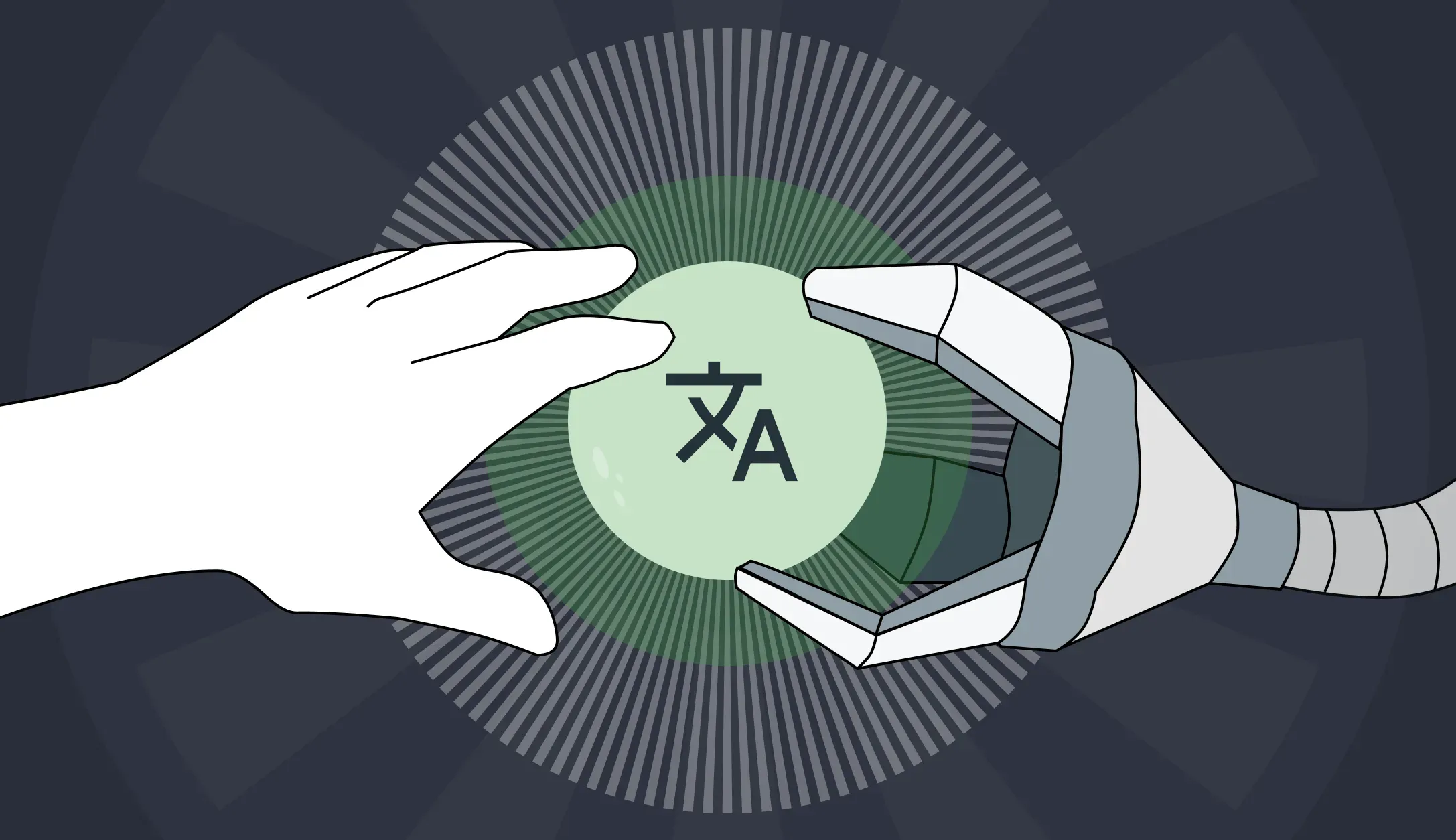Recent technological advancements allow businesses to turn to machine translation post-editing. According to Nimdzi’s industry report, about 50% of companies post-edit their machine translations.
The concept is simple: combine the speed of machine-translated text with a linguist’s review.
The translation industry has advanced a lot. Yet raw machine-generated output still requires a human touch to achieve professional standards. And this is where you need machine translation post-editing (MTPE).
What is Machine Translation Post-Editing (MTPE)?
Machine Translation Post-Editing (MTPE) is a process of reviewing, correcting, and improving raw machine translation output. A human editor ensures the final result is grammatically correct and meets the set of standards.
In traditional workflows, the process starts from a human working on a pre-translated text. In machine translation, post-editing starts from the machine-translated text. Then, a professional refines the output.
Such an approach combines the benefits of human and machine translation. It eliminates machine errors while humans ensure accuracy.
Some projects need minimal editing to achieve basic readability. Others demand extensive revision. The scope of post-editing depends on:
- project requirements
- target audience expectations
- budget constraints
Difference Between Post-Editing Machine Translation and Editing Human Translation
The difference between editing human translation and post-editing machine translation lies primarily in the depth of the required work.
When editing human translations, editors primarily focus on polishing the text. Their work centers on improving style, ensuring terminology consistency, and making minor corrections. Since the structure and meaning are already correct, you usually only need to make small, surface changes.
Post-editing machine translation demands a much more comprehensive effort. Translators must correct repeated errors, rewrite awkward sentences, improve the flow, and sometimes even completely re-translate to achieve acceptable quality.
Basically, correcting translations after a human is simpler than correcting them after a machine.
2 Types of Post-Editing: Light vs. Full Post-Editing
There are two primary types of post-editing. The choice depends on budget limitations, initial MT output, content type, and other factors. Let’s take a look at them.
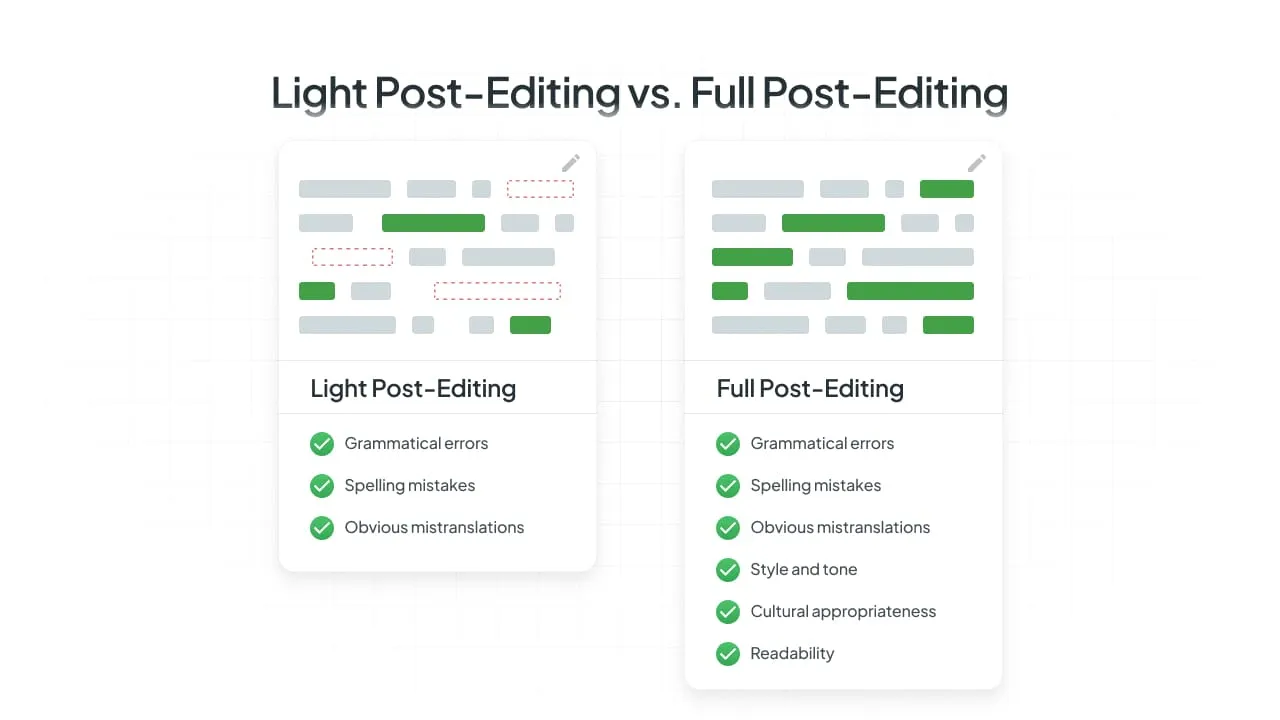
1. Light Post-Editing
Light post-editing focuses on correcting major errors after MT translation. At the same time, the process is fast and efficient. Light post-editing fixes:
- grammatical errors
- spelling mistakes
- obvious mistranslations
So, the main goal is to produce understandable and accurate content. You don’t spend time on stylistic or tone improvements. The main benefit is speed, allowing translators to process 2-3 times more words per hour. Yet the result will still contain minor awkwardness. Thus, the quality discussion must be upfront to avoid expectation errors.
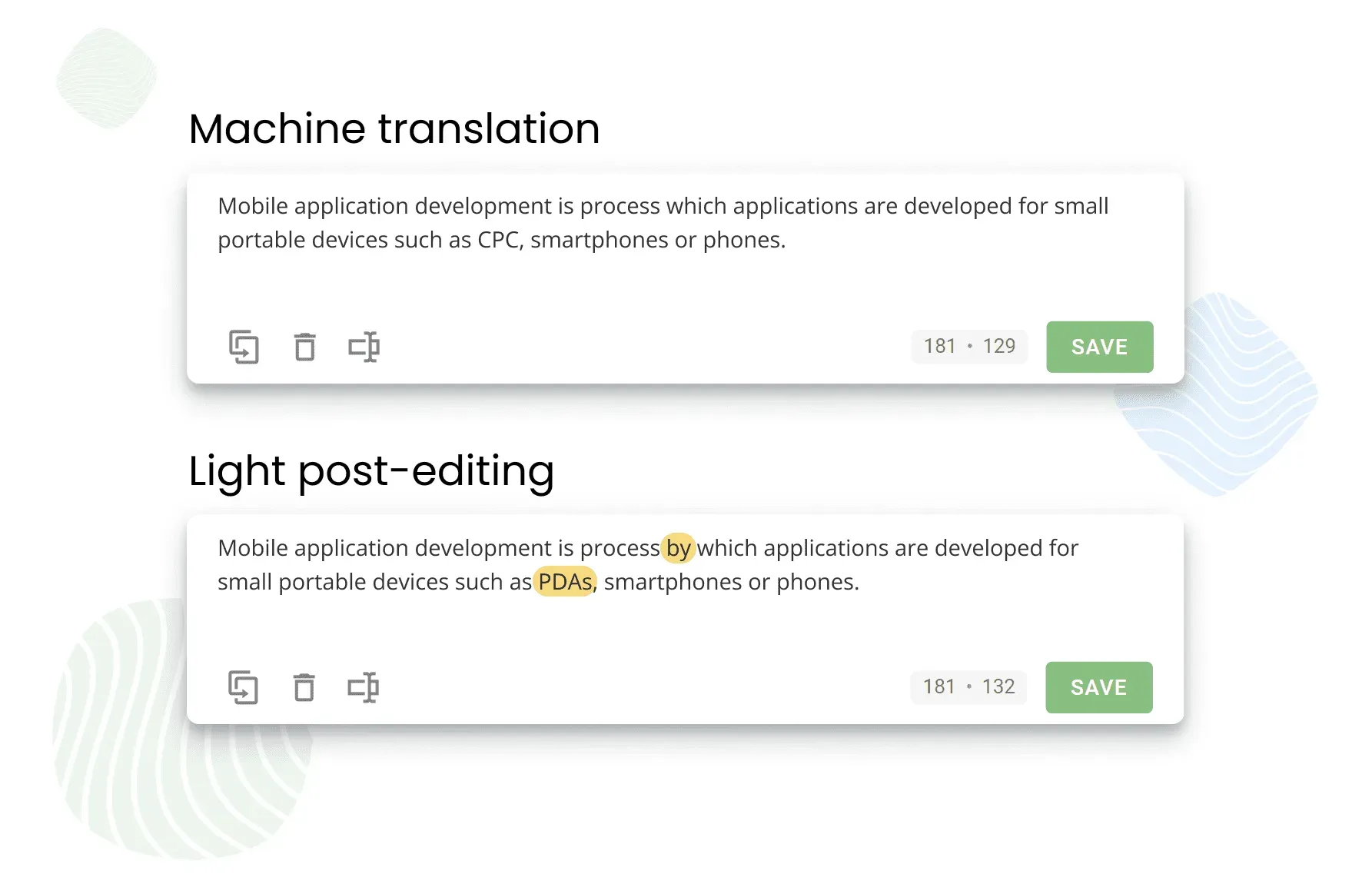
2. Full Post-Editing
The goal of full post-editing is to achieve translation quality comparable to that of human translation. It addresses not only accuracy and comprehension issues, but also:
- style and tone
- cultural appropriateness
- readability
Full post-editing involves extensive revision of the MT output, including:
- sentence restructuring
- terminology optimization
- stylistic improvements
This approach is more suitable for the content, the quality of which can impact a brand’s reputation. The quality of the result is comparable to the human translation, with 15-30% better productivity.
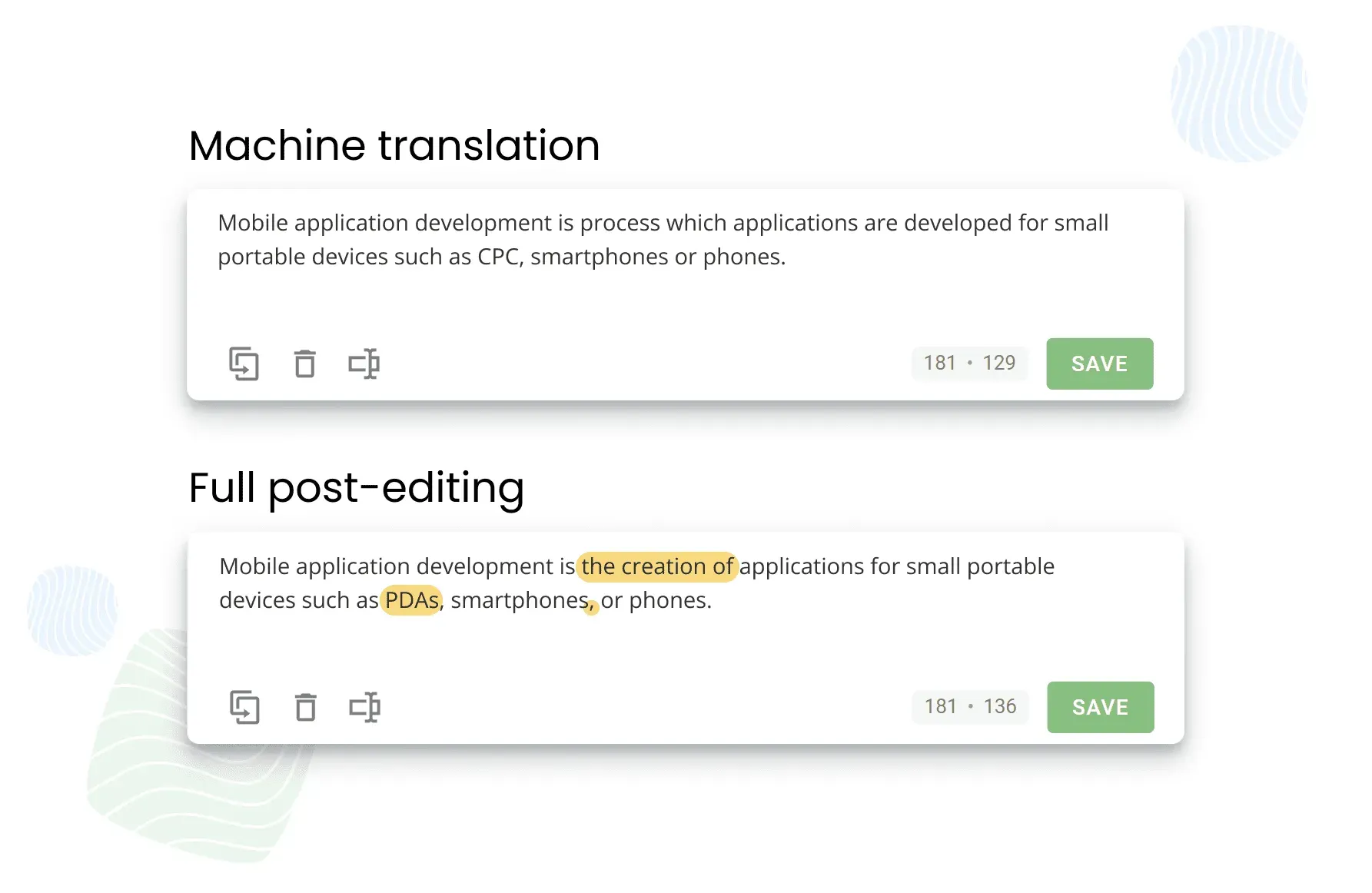
According to Slator, human translators on average produce 200-300 words per hour. When light and full post editing produce approximately 1000 and 600-800 words per hour.
Post-Editing Use Cases
The choice of approach depends on the type of content and its intended purpose. Light post-editing works well for:
- Software interface translations for internal testing
- Technical documentation updates requiring quick turnaround
- User-generated content moderation
- Internal communications and status reports
- High-volume e-commerce product descriptions
Companies turn to full post-editing for:
- Marketing materials and advertising copy
- Legal documents and contracts
- Medical and pharmaceutical content
- Educational materials and training content
- Customer support documentation and help articles
Why Machine Translation Post-Editing (MTPE) Matters
Despite the high usage of Machine Translation (MT), human revision is still needed for most of the output. The need for this extensive editing is driven by common MT issues, which are outlined below.
Improves Grammatical Accuracy and Spelling Mistakes
Grammatical errors can be present in the machine-translated text, which can compromise the brand’s image. Translators not only fix mistakes but also correct problems unique to each MT engine.
As an additional benefit, human review provides feedback that helps continuously improve the MT engine.
Handles Cultural Nuances and Idiomatic Expressions
Cultural nuances and idioms that need deep understanding and do not have a literal alternative cannot be adapted with MT. Such translations require creative interpretation and localization expertise that current MT systems cannot replicate.
Reduces Errors in Machine-Generated Translation
Understanding these patterns and creating strategies enables post-editors to work faster and ensure quality improvements. Error patterns in machine-generated translation often link to specific parts:
- content types
- domains
- language pair features.
MTPE Workflow: How It Works
The machine translation post-editing consists of several steps. Each one plays a crucial role in creating quality output with less effort and lower cost.
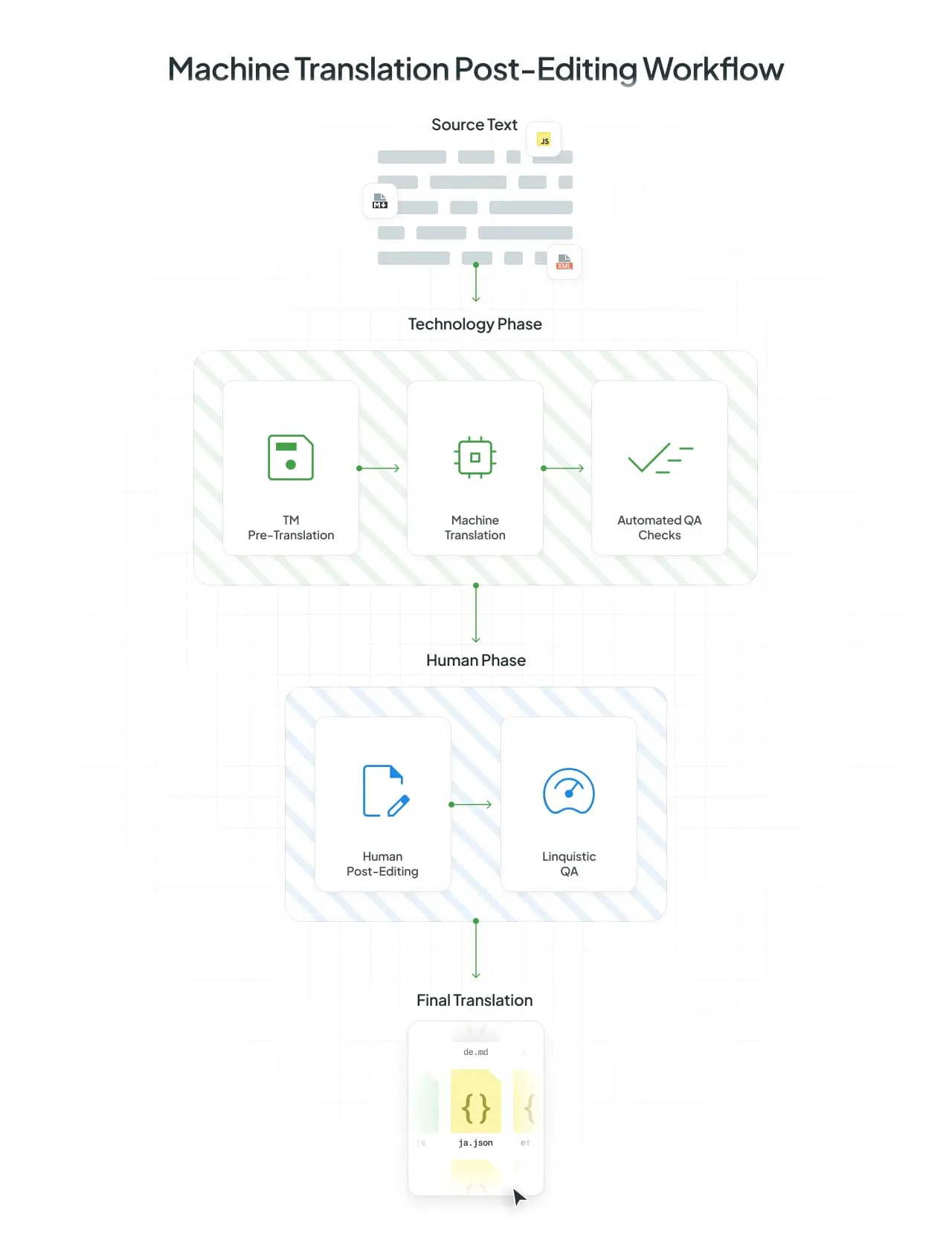
1. Pre-Editing and Preparing Source Text
The first step is pre-editing – source text optimization that includes:
- simplifying complex sentences
- clarifying ambiguous references
- ensuring consistent terminology
- fixing mistakes
It helps MT engines improve initial output and reduce the scope of post-editing. Project managers should also establish clear guidelines for source text quality and MT system configuration.
Translation memory and glossary preparation are also critical for improving text accuracy and reducing costs. It includes feeding previous translations and approved terminology into the MT system.
2. Selecting the Machine Translation Engine and Translation Memory
Modern workflows integrate machine translation engines with translation memory databases. Translation memory matches provide extra context and consistency cues for post-editors. This maximizes both quality and efficiency for common language pairs and general content domains.
High-percentage matches from previous projects often need minimal post-editing. At the same time, lower matches guide correction decisions and maintain terminology consistency.
The integration continues to evolve because of the feedback loop. Remember, selecting appropriate MT engines for specific content types and language pairs requires ongoing evaluation.
3. Human Post-Editing
Successful post-editing workflows strike a balance between efficiency and quality. Professionals create their own structured patterns that cut repetitive tasks.
Linguists tend to work with specialized CAT tools. These present MT output alongside source text and translation suggestions.
The typical workflow includes:
- common error correction
- attentive review of complex parts
- quality checkpoints
- independent review (for critical content)
- KPI (to track productivity and quality)
4. Quality Assurance (LQA): MT Quality and MT Accuracy
Machine translation post-editing differs from traditional translation, based only on the work of human experts. Use Linguistic Quality Assurance (LQA) to focus on key areas like:
- error density
- correction effort required
- final output acceptability
Regular quality assessments should check both post-editing consistency and quality trends. This allows for making data-based decisions and identifying opportunities for improvement and training.
Crowdin TMS offers integration with services like TAUS QE & APE (Quality Estimation and Automatic Post-Editing) as a workflow step to automatically evaluate and improve machine translation output, further improving the post-editing process.
Tools for MTPE
Use these tools to prepare the source text or train the MT system before the post-editing begins, to improve initial machine translation quality. That makes the post-editing step much simpler and quicker.
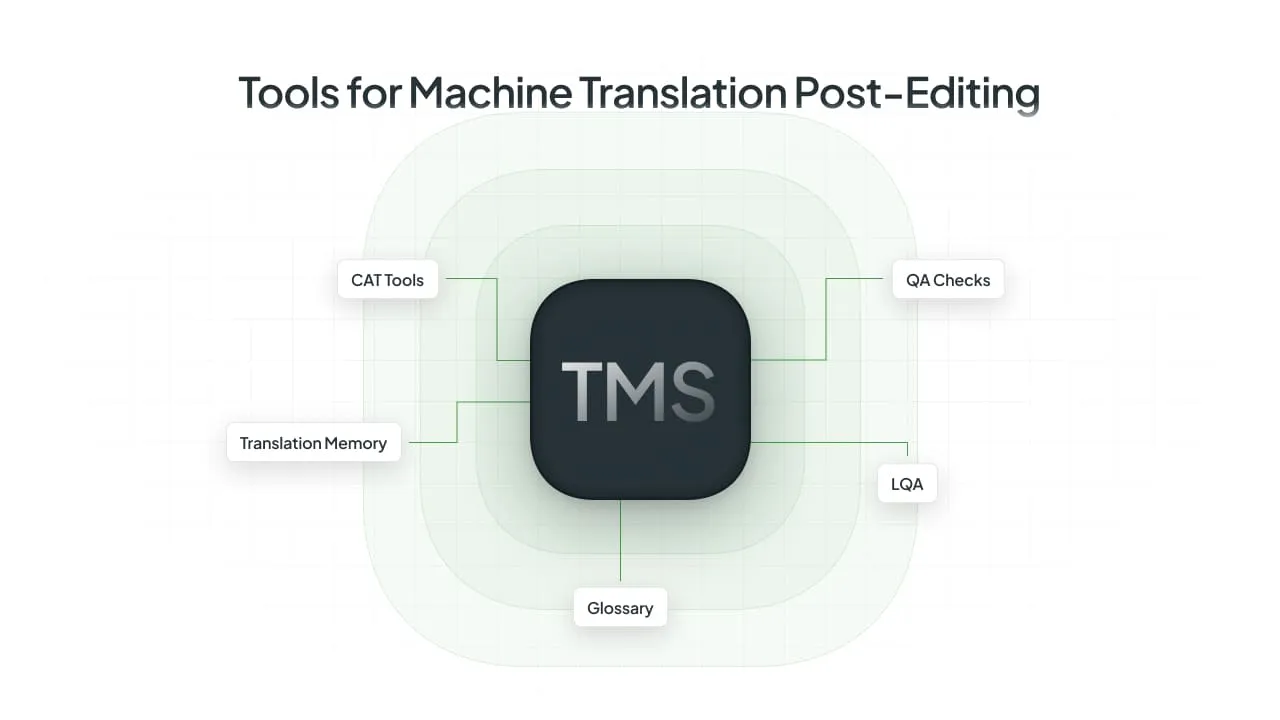
Translation Management System (TMS)
TMS is your tool number one. This is the central command center for all your translation work. It’s a software platform designed to manage and automate the entire process, acting as the single place where your team works. A good TMS is important because it brings together or connects all the necessary tools, including MT itself, Translation Memories, Glossaries, and QA Checkers.
Localization platforms like Crowdin offer a unified environment with features specifically for machine translation post-editing (MTPE). This includes:
- collaboration tools
- in-context preview + Figma integration (so editors see the final layout)
- context from the screenshots and text
- integrations to connect your content directly to the system
- built-in qa checks
- translation memory, glossary
- different MT providers
Want to see how it all works?
Machine Translation Systems
Choosing the MT system impacts the post-editing process. Understanding the options helps companies make the best decision and achieve the desired result:
- Neural machine translation systems produce output with less extensive correction than earlier approaches. Example: Google Translate, DeepL Translator.
- Rule-based systems produce predictable errors that experienced post-editors can address. But quality limitations often need extensive revision.
- Statistical MT systems provide improved fluency. But they produce different types of errors requiring different correction strategies.
Neural machine translation is currently the best solution. It provides fluency and accuracy in different languages. But still requires human expertise to add nuances, terminology, and creativity.
Translation Memory
Translation memory integration with MT systems provides extra context and consistency. It can reduce post-editing effort for repetitive content types. Technical documentation is one of the examples.
The quality matches affect post-editing efficiency. This makes database maintenance and quality control important ongoing activities for post-editing programs.
Remember that post-edited segments are fed back into memory databases. This allows to improve and reduce correction effort.
Integration with CAT Tools
Modern CAT tools provide infrastructure to manage repetitive tasks and quality checks. It shows the MT output alongside the source text, translation memory, and references. This way, translators can be more productive, focused on separate segments.
Glossary
The Glossary is a list of approved company or project-specific terms. It ensures that technical terms and brand names are consistently translated.
When integrated into MT, the Glossary automatically suggests or checks the correct term, which is vital for keeping specialized content consistent and accurate.
QA Checker
The QA Checker is the automated final spell-check for quality. After the human editor is finished, this tool automatically scans the text for objective, easy-to-miss mistakes—things like double spaces, missing punctuation, incorrect numbers, or forgetting to use a term from the Glossary.
Quality assurance guarantees that the final translation meets all technical standards before it is passed to post-editing.
6 Best Practices for Effective MTPE
Every company wants to avoid the common machine translation mistakes. This is why we have compiled a list of the best practices to help you reach new markets with MTPE.
1. Train Your Post-Editors
Effective post-editing begins with skilled editors who understand both the source language and the intent behind machine-generated output.
Invest in training, so your post-editors can recognize common MT patterns, correct subtle linguistic errors, and maintain consistency with project-specific requirements. Well-trained editors improve translation overall quality and reduce the time needed for proofreading.
2. Use High-Quality Source Text
The quality of the source text directly affects the quality of machine translation. Clear, well-structured, and unambiguous input reduces the likelihood of errors and minimizes the effort required during post-editing.
A single mistake in the source language can be exponentially multiplied, leading to 10 more errors across 10 different target languages.
Make your source materials free of jargon, inconsistent terminology, and complex sentence structures to receive better machine-generated translations. Better MT translations – less time spent on MTPE.
3. Define Clear Quality Guidelines (The Rulebook)
Establishing precise quality expectations allows post-editors to work efficiently. Create the “rulebook” that post-editors must follow. These guidelines should outline preferred terminology, stylistic conventions, acceptable levels of modification, and specific do-not-change rules tailored to the project.
Clear instructions prevent over-editing, reduce variability among editors, and ensure that every revised text meets the same standard of accuracy and readability.
4. Ensure Consistent Quality Across Language Pairs
Quality consistency across language pairs requires standardized processes, clear guidelines, and regular assessment. These help identify and address MT performance variations and post-editing effectiveness. The primary considerations are:
- MT system selection
- common error patterns
- cultural adaptation requirements that may affect post-editing approaches
- quality standards for target markets
- cross-linguistic quality metrics to identify differences and optimization opportunities
- shared resources and regular team communication
- consistent training
First, create the rulebook mentioned in step 3, and then use a strategy to apply that rulebook successfully across all your global markets.
5. Measure Success (Edit Distance & Speed)
To evaluate the effectiveness of your post-editing process, track quantitative metrics such as edit distance (how much the editor must change the MT output) and editing speed. Lower edit distances indicate higher MT quality, while improved speed shows greater post-editing efficiency.
Monitoring these metrics over time helps identify bottlenecks, assess training effectiveness, and guide future improvements in both machine translation and post-editing practices.
6. Leverage Cultural Expertise
Cultural expertise goes beyond linguistic accuracy. It ensures the content is suitable and effective for specific markets.
Here’s where team diversity plays a crucial role. It brings diverse perspectives and expertise to get the most effective outcome. To measure cultural quality, check appropriateness and effectiveness, and not only accuracy.
Key Takeaways for MTPE
Machine translation post-editing has matured into a sophisticated approach. It combines technological efficiency with human expertise
Success requires careful planning, appropriate tool selection, and investment in training and process optimization. Measurement and continuous improvement are essential for long-term success. Comprehensive metrics for tracking both quality and efficiency outcomes are also important. They support ongoing optimization and show business value.
MTPE Role in Multilingual Content Delivery
Post-editing machine translation plays a strategic role in multilingual content delivery. The approach particularly benefits organizations with high-volume, routine content requirements.
For organizations considering post-editing implementation, Crowdin offers comprehensive solutions that integrate MT systems with professional post-editing workflows, providing the tools and expertise needed for successful multilingual content delivery.
Learn more about localization best practices. Explore how software localization can benefit from strategic post-editing approaches. Visit the Crowdin blog for more insights on translation technology and industry trends.
Localize your product with Crowdin
Frequently Asked Questions (FAQ)
What’s the Difference Between Light and Full Post-Editing?
Light post-editing focuses on correcting errors that impede comprehension while maintaining high productivity. The errors include grammatical mistakes and obvious mistranslations. Full post-editing aims for human translation quality through comprehensive revision. It includes style, tone, and cultural appropriateness improvements.
How to Decide if Content is Fit for MTPE?
Content suitability for machine translation post-editing depends on several factors. These include complexity, target audience, quality requirements, and available resources. Routine, structured content with clear terminology works well. While creative, sensitive, or specialized content may need traditional translation approaches.
Which Tools are Essential for MTPE?
Essential tools include:
- modern CAT tools with MT integration
- comprehensive translation memories
- terminology databases
- quality assurance tools.
Quality assurance tools help maintain consistency and catch errors throughout the post-editing process.
When to Avoid MTPE in Favor of Transcreation?
Avoid post-editing for creative content and marketing materials requiring cultural adaptation. Also for content where brand voice and emotional impact are crucial. Learn more about transcreation.
Diana Voroniak
Diana Voroniak has been in the localization industry for over 4 years and currently leads a marketing team at Crowdin. She brings a unique perspective to the localization with her background as a translator. Her professional focus is on driving strategic growth through content, SEO, partnerships, and international events. She celebrates milestones, redesigns platforms, and spoils her dog and cat.
